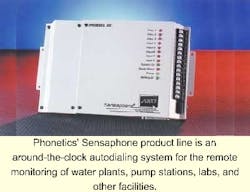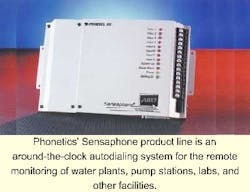New System Helps Utility Meet Monitoring Requirements
The Ohio Water Equipment Company of Plain City (OWEC) provides water plant operator services to facilities throughout Ohio, including several of the largest travel center operations in the United States. The rest-stop facilities are open and operating 24 hours a day, seven days a week.
Monitoring these and other facilities is costly and complicated, requiring OWEC to provide the daily measurement information required by the Ohio Environmental Protection Agency (EPA) for variables such as flow rate, total gallons per day, free and total chlorine levels, pressure and wet floor sensing.
All of OWEC's water plants, for example, must maintain at least 20 psi water pressure at all times, and chlorine residuals must be at least 0.2 mg/l free and/or 1.0 mg/l combined. To monitor these conditions, the Ohio EPA required a minimum of five site visits per week by an EPA-certified water plant operator. This monitoring became time-consuming and costly; OWEC sought a more efficient solution and investigated plant-monitoring systems.
During the original evaluation process, OWEC compared literature, specifications, and prices for various plant-monitoring systems. SCADA systems appeared effective, but most systems provided more features than OWEC required for many of its applications. However, one product - the SensaphoneRegistered 2000 from Phonetics, Inc. (Aston, PA) - offered a flexible monitoring system that allowed OWEC to choose just the features it needed.
Phonetics' Sensaphone product line is an around-the-clock alarm autodialing system for the remote monitoring of water plants, pump stations, labs, and other facilities. When environmental conditions in these facilities deviate from optimal, users are notified by the units' alarm and autodialing capabilities. Immediate, remote notification helps minimize contamination, overflow, disruption, and repairs. System users also can phone in to their system at any time to access data reports on all monitored conditions.
"We evaluated other systems, but given the price, quality, and specific features of the Phonetics' product line, the choice was obvious," said Ron Jordan, President of OWEC. "Based on the results of a six-month field test of a Sensaphone 2000 model, we determined that the equipment was reliable, user friendly, and a valuable addition to our overall plant operation."
The new monitoring system helped the company overcome its primary challenge - meeting Ohio EPA daily measurement requirements. Now, the company is required to visit a site only one to two times per week versus the previous five. A subsequent reduction in onsite staffing has lower expenses and has proven to be another key benefit.
System Highlights
Sensaphone 2000 can report on up to eight remote, analog or digital conditions including room temperature, outside temperature, humidity, tank levels, tank temperature, pressure, flow rates, flooding, and HVAC controllers, plus power failure. It can be programmed to communicate with up to 32 destinations to deliver alarm messages or status reports in real-time. User programmability allows customization.
The system also has built-in data-logging features capable of storing up to 32,000 records. It can communicate via any combination of telephones, fax machines, pagers, e-mail accounts, or computers. Plus, alarm and critical data point information can be automatically formatted into a Web page and uploaded to a specific Web site for online access.
"As of February 2001, the federal government has mandated that all private water systems serving more than 25 of the same people in a six-month period will be required to hire the services of a certified water plant operator. The states are required to enforce this mandate and will lose 20 percent of their EPA funding if they do not," Jordan said. "Sensaphone systems will help to ensure compliance with the new federal regulations, while offering the end-user a way to accomplish this and save considerable costs over traditional methods."

